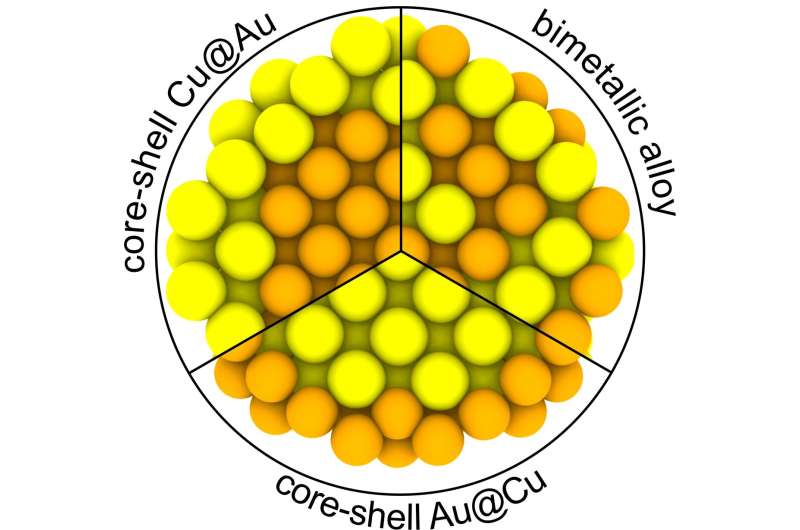This article has been reviewed according to Science X's editorial process and policies. Editors have highlighted the following attributes while ensuring the content's credibility:
fact-checked
peer-reviewed publication
trusted source
proofread
New results to help fine-tune catalytic properties of bimetallic nanoparticles

Nanoparticles range in size from 1 to 100 nanometers, and compared with usual particles, they are known to have unique features that are increasingly used for diagnosing cancer, developing small electronic devices and solar batteries, as well as in many other spheres.
In their new paper published in Physical Review B, researchers from Skoltech revealed that catalytic properties of bimetallic nanoparticles—when a material accelerates or delays a chemical reaction without being consumed by the reaction—can be fine-tuned while changing the structure of the nanoparticle.
As of now, of greatest interest are bimetallic core-shell particles, in which the core and the shell consist of different metals. Researchers studied three types of nanoparticles: Cu-core/Au-shell, Au-core/Cu-shell, and homogeneous bimetallic AuCu alloy particles. Unlike core-shell particles, the structure of usual bimetallic particles is not ordered.
"We observed how different core-shell ratios can change electronic states on the surface. These changes have an impact on the binding ability between a nanoparticle and a molecule of CO. We concluded that it is possible to double the adsorption energy—more precisely, chemisorption, which is a chemical binding between atoms, molecules of gases and the surface of the crystal or nanoparticle—in relation to a pure metal through fine-tuning the core-shell ratio in the nanoparticle," said Research Scientist Ilya Chepkasov from the Material Discovery Laboratory, the leading author of the study.
The study involved several stages and used density functional theory. In the first stage, the team used nanoparticles sized 2 nanometers to construct core-shell particles with different core-shell ratios and analyzed how the surface charge changed depending on the ratio. Afterward, the researchers calculated the adsorption of CO and O molecules on the surface of nanoparticles and demonstrated how adsorption properties of nanoparticles can be changed through varying the surface charge associated with fine-tuning its structure.
"We revealed fundamental patterns that will be later used to develop AI-driven models for effective prediction of the adsorption and catalytic properties of bimetallic nanoparticles while performing high-throughput screening for new materials with specified properties," added Professor Alexander Kvashnin from the Energy Transition Center, the head of the research.
The results prove that fine-tuning the structure of nanoparticles helps to find the necessary catalytic properties of nanoparticles, which will help to control the catalyst. The practical relevance lies in improving gas purification—for example, for cleaning technical gases from highly toxic CO and making them safer.
More information: Ilya V. Chepkasov et al, Structure-driven tuning of O and CO adsorption on AuCu nanoparticles: A density functional theory study, Physical Review B (2023). DOI: 10.1103/PhysRevB.108.205414
Journal information: Physical Review B
Provided by Skolkovo Institute of Science and Technology





















